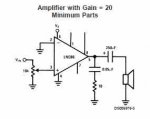I have a relatively simple question?..
What it the correct method to build a simple Picaxe volume control for the project I am building?
Why am I asking for help? I have spent many hours in the last week trying to figure out the best method.
Requirement: Volume control for an amplified sound output using a Picaxe 08m which is using the tune basic instruction to an 8 ohm magnetic/coil speaker.
What I know.
What I cannot do is amplify and control.
Arghhhh!!! What am I doing wrong?
Thank you in anticipation.
________
What it the correct method to build a simple Picaxe volume control for the project I am building?
Why am I asking for help? I have spent many hours in the last week trying to figure out the best method.
Requirement: Volume control for an amplified sound output using a Picaxe 08m which is using the tune basic instruction to an 8 ohm magnetic/coil speaker.
What I know.
I can implement a simple volume control by placing 33R resistor in series to generate a total resistance of 41R (as per the documentation) to the + side of the speaker, then implementing a 50k pot across the two connectors of the speaker. This works.
What I cannot do is amplify and control.
I was to implement a simple M386 amp but I cannot get the sound stable. I get volume control via the 10k pot on the input to LM386 but I cannot shut the sound off and at the full range of 10k the sound drops of instead of increasing.
Arghhhh!!! What am I doing wrong?
Thank you in anticipation.
________
Last edited by a moderator:




